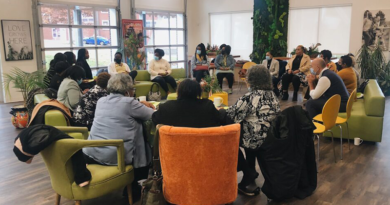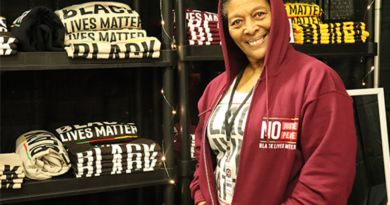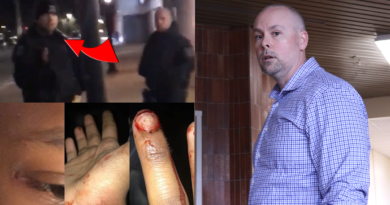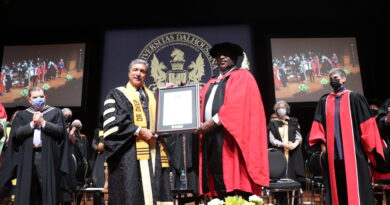Plaque honouring Viola Desmond unveiled outside former Roseland Theatre in New Glasgow [VIDEO]

On Friday, a plaque was unveiled outside of the former Roseland Theatre in New Glasgow where Viola Desmond was arrested in 1946 for sitting in the whites-only section. The plaque was unveiled on behalf of Parks Canada and the Historic Sites and Monuments Board of Canada (HSMBC).
Rev. Dr. Peter J. Paris was one of the speakers at the unveiling cerermony. Paris was 13 years old and living in New Glasgow when Desmond was arrested.
“I clearly remember hearing my parents and others discussing the incident and lamenting the injustice inflicted on such a young fine businesswoman,” Paris told a crowd gathered on Viola’s Way, the pedestrian-only street adjacent to the building renamed in Desmond’s honour.
Current and former members of New Glasgow’s Black community were in attendance at the unveiling ceremony, which coincides with the New Glasgow Black Homecoming Gala that takes place until Sunday.

At the unveiling ceremony, former Lieutenant-Governor Mayann Francis talked about Desmond’s first career as a teacher. Desmond had to receive her education through correspondence because Black students were not permitted to attend the teachers college in Truro in person.
When she graduated, Desmond was permitted to teach only in segregated Black schools, like other Black teachers at the time.
She switched careers and went on to study beauty in Montreal because all the beauty schools in Halifax were for white students. She came back to Halifax and opened a beauty salon, a beauty training school, and started her own line of beauty products for Black women.
“She was unique because she was a successful Black businesswoman during a time when race relations in this province were dismal,” said Francis. “She understood the value of hard work and empowerment.”

Paris spoke about some of the lesser-known details surrounding Desmond’s arrest and its subsequent fallout.
“Her refusal to sit in the segregated section was not a protest against segregation, per se,” Paris said, “but was due simply to her short-sightedness and inability to see the screen from the balcony.”
“Desmond’s appeal was undertaken by the NAACP of Nova Scotia under the guidance of a former New Glasgow native, Mrs. Pearleen Oliver, and her husband Dr. William P. Oliver.”
“Her courageous action was publicized by the renowned Dr. Carrie Best, who had experienced a similar incident five years earlier in the company of her young son Calbert. Best gave wide coverage of the event in her newly founded Clarion newspaper.”
Paris said for Black Nova Scotians Desmond “became a visible public symbol” of racial discrimination “that was once pervasive in our town and throughout our province.”
The province issued an official apology and free pardon to Desmond in 2010.
History in perspective

Paris said it’s important to understand history in its fullest and proper context.
“It can be elusive. It can take away from the actual story that’s happened by trying to wind it up into another story,” he said when speaking of common comparisons of Desmond to Rosa Parks. “Even though she’s been called the Rosa Parks in Canada, or of Nova Scotia, she did her own thing in a different way.
“[Rosa Parks] was involved in an organized protest whereas Viola Desmond was not involved in an organized protest. It was an individual action that then took on more dimension.”
To Paris, now in his late 80s, blatant and overt racial segregation and discrimination in New Glasgow is not just an abstract concept; it’s something he remembers he and his family experienced during his lifetime.
Paris said when he was young he remembers his parents were turned away from an outdoor street dance in downtown New Glasgow.
“And it was just a travesty in my point of view that we watched our mother and father getting dressed and they were so excited, and friends coming to join them and they were coming downtown, only to be turned away. All the Black people were turned away.”
He said he remembers one of his sisters being refused service from a local hairdresser. He said some hairdressers would provide service for Black customers but only after hours.
Paris said he and his family would often attend Saturday matinees at Academy Theatre not far from the Roseland Theatre where Desmond was arrested.
Though the Academy Theatre was also segregated for the most part, it was desegregated in the afternoons when he and his family would attend.
“But we just never felt comfortable at the Roseland Theatre. They were just not welcoming of Blacks, so we never came here.”
African Canadian contribution

Sean Fraser, Liberal MP for Central Nova, said in 2018 when he was the minister responsible for Parks Canada, he had a conversation about designating the building that housed the former Roseland Theatre a national historic site.
Fraser said due to rules and regulations — and the fact the building had undergone significant changes and no longer served the same purpose — it was not possible to designate the building itself.
“But some smarter people than me got together and said, ‘Well, what about the person?’ And I can’t tell you how much more appropriate it is to honour the person that justifies our presence here today,” Fraser said.
Just prior to the plaque’s unveiling, Bernard Thériault from the Historic Sites and Monuments Board of Canada (HSMBC) read its inscription. Thériault said the unveiling was the third in the last two months he’s attended that paid homage to the contributions of African Canadians.
In June, a plaque was unveiled in Calgary that honoured the late John Ware, a former slave who became a successful cowboy and rancher in Alberta in the late 1800s. Two of Ware’s sons went on to join the No. 2 Construction Battalion.
Thériault credited Desmond’s sister Wanda Robson for “the significant role she played in raising public awareness” of Desmond’s story.
He also credited Graham Reynolds, professor emeritus and the Viola Desmond chair in social justice at Cape Breton University, for applying to have Desmond recognized as a person of national significance.

Friday’s unveiling was streamed on the YouTube channel for the Black Cultural Centre for Nova Scotia. Earlier this week, Russell Grosse, the centre’s executive director, told the Examiner about the significance of the 2010 apology from the province to Desmond and of Friday’s national historic designation.
“When you think of the definition of a historic site or monument in Canada, they’re not about, commemorating things that will create change for systemic issues. It’s about marking a point in Canadian history so that that point isn’t forgotten,” Grosse said.
“The many things that ensued from [the apology], whether it’s the naming of streets or the $10 banknote or the Canada Post stamp or the ferry naming, it all started in that location.”








